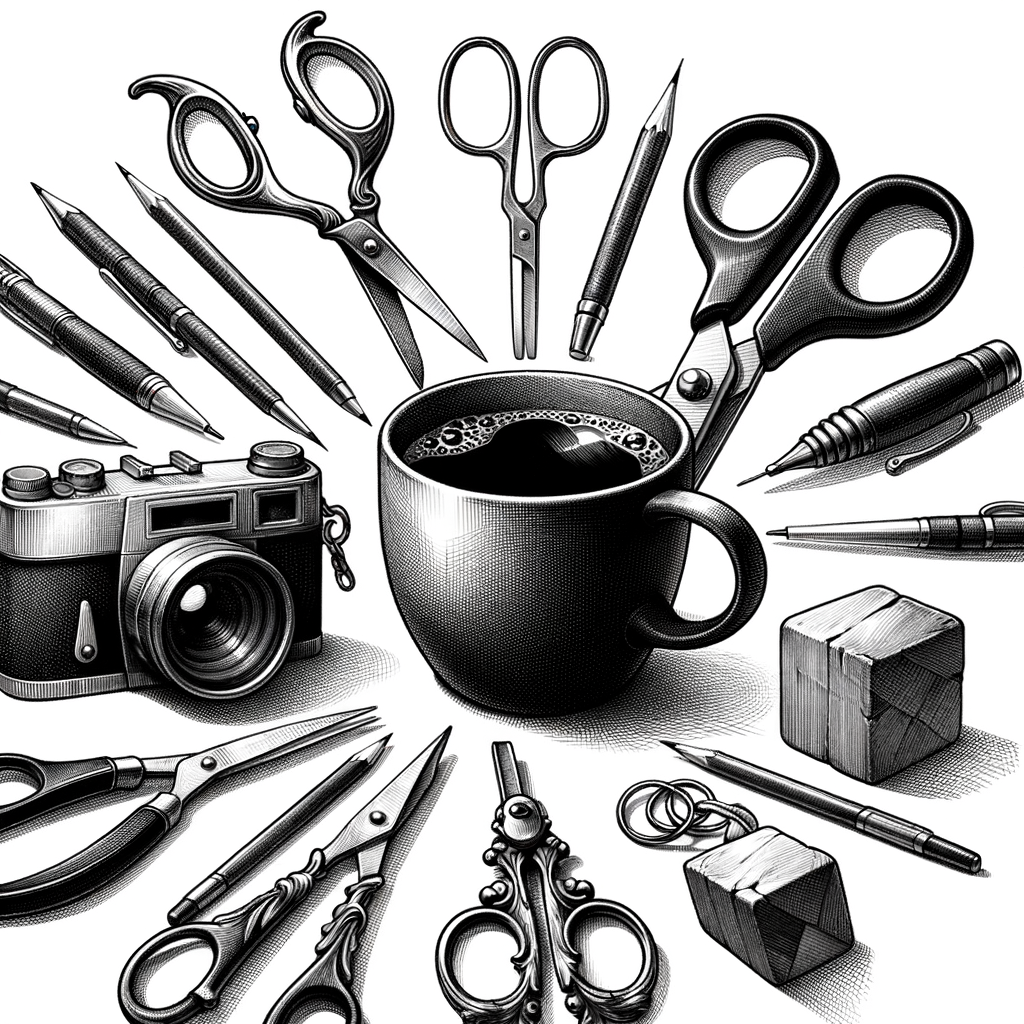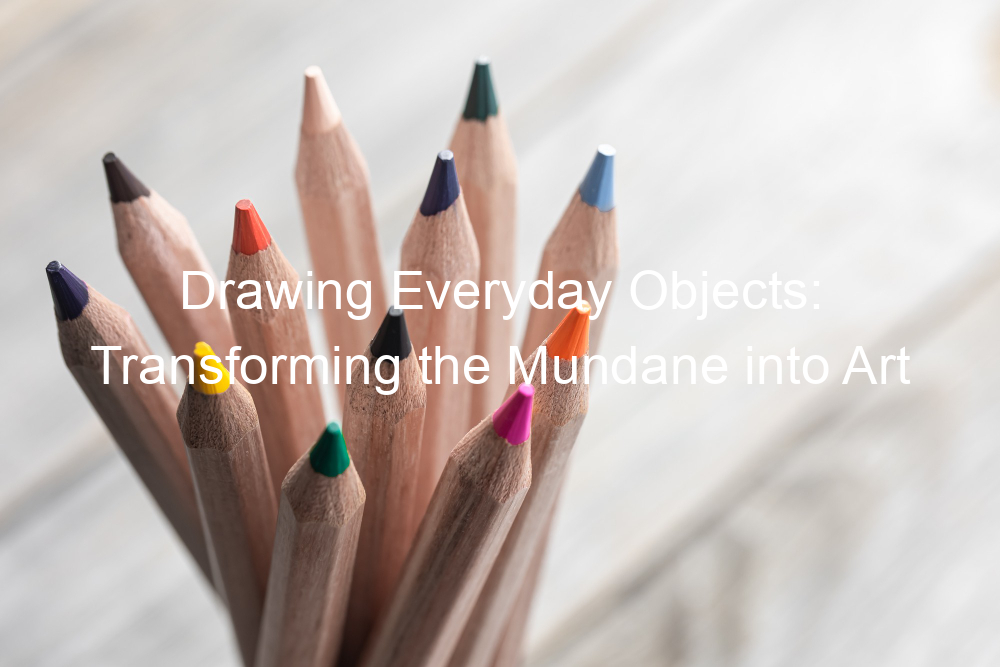
Introduction to Drawing Everyday Objects
-
Understanding the concept of turning mundane into art:
Drawing everyday objects can be a fun and creative way to see the world differently. When you sketch something simple, like a cup or a shoe, you start to notice details you might have missed before. This practice helps you appreciate the beauty in ordinary things. -
Benefits of sketching daily objects:
There are many benefits to drawing everyday items. First, it helps improve your observation skills. You learn to see shapes, shadows, and textures more clearly. Second, it can be very relaxing. Taking a few minutes each day to draw can reduce stress. Finally, it boosts creativity. By turning simple objects into art, you train your brain to think creatively.
Artistic Everyday Objects: The Basics
Choosing Your Everyday Items for Sketching
-
How to select suitable mundane objects for art:
When picking items to draw, start with things you see every day. Look for objects with simple shapes. This makes it easier to practice your skills. Choose items that have interesting textures or patterns. This can make your drawings more fun and detailed.
Think about the size of the object. Smaller items are easier to handle and draw. Also, consider the lighting. Good lighting can help you see details better.
-
Examples of common household items to draw:
Here are some everyday items you can start with:
- Fruit: Apples, bananas, and oranges are great choices. They have simple shapes and interesting textures.
- Kitchen Utensils: Spoons, forks, and knives are easy to find and have unique shapes.
- Books: A closed book is simple, while an open book offers more detail.
- Plants: Small potted plants or flowers can add a touch of nature to your drawings.
- Clothing: A hat, a pair of shoes, or a scarf can be interesting to draw because of their folds and textures.
Object Why It’s Good for Drawing Fruit Simple shapes, interesting textures Kitchen Utensils Unique shapes, easy to find Books Simple or detailed, depending on open or closed Plants Adds a touch of nature, various shapes Clothing Folds and textures make it interesting
Materials Needed for Drawing Household Items
- Essential drawing tools: To start drawing everyday objects, you need some basic tools. These include:
- Pencils: A set of pencils with different hardness levels (e.g., HB, 2B, 4B) helps create various shades and details.
- Erasers: A good eraser is essential for correcting mistakes and adding highlights. Consider using both a kneaded eraser and a standard one.
- Paper: Choose a sketchbook or drawing paper that suits your style. Thicker paper is better for detailed work.
- Sharpener: Keeping your pencils sharp is crucial for fine lines and details.
- Additional materials for enhancing your artwork: These materials can help you add more depth and interest to your drawings:
- Colored Pencils: Adding color can bring your drawings to life. A set of colored pencils offers a wide range of hues.
- Blending Tools: Tools like blending stumps or tortillons help smooth out pencil strokes and create soft transitions.
- Rulers and Compasses: For precise lines and shapes, these tools are very useful.
- Fixative Spray: This spray helps protect your finished artwork from smudging.
| Tool | Purpose |
|---|---|
| Pencils | Creating various shades and details |
| Erasers | Correcting mistakes and adding highlights |
| Paper | Providing a surface for drawing |
| Sharpener | Keeping pencils sharp |
| Colored Pencils | Adding color to drawings |
| Blending Tools | Smoothing out pencil strokes |
| Rulers and Compasses | Creating precise lines and shapes |
| Fixative Spray | Protecting artwork from smudging |
Techniques for Drawing Common Items
Observation and Perspective
-
Importance of observing everyday objects:
Observing everyday objects closely helps you notice details you might miss at first glance. This can make your drawings more accurate and interesting. For example, look at a simple apple. Notice its shape, color, and the way light reflects off its surface.
-
How to draw from different perspectives:
Drawing from different perspectives means looking at objects from various angles. This can make your drawings more dynamic. Try drawing a chair from above, below, and the side. Each angle will show different parts of the chair and make your drawing more complete.
| Technique | Benefit |
|---|---|
| Observation | Improves detail and accuracy |
| Perspective | Adds depth and interest |
Shading and Texture
-
Techniques for Shading Everyday Items
Shading adds depth to your drawings. It makes objects look real. Here are some techniques:
- Hatching: Draw parallel lines close together. The closer the lines, the darker the shade.
- Cross-Hatching: Draw another set of parallel lines over the first set. This creates a darker shade.
- Blending: Use your finger or a blending tool to smooth out pencil marks. This creates a soft shadow.
- Stippling: Make tiny dots. The more dots you add, the darker the area will look.
Try these techniques on simple objects like apples or cups. Practice will make you better!
-
Creating Texture in Your Drawings
Texture makes your drawings interesting. It shows how something feels. Here are some ways to create texture:
- Lines: Use different types of lines. Wavy lines can show a rough surface. Straight lines can show a smooth surface.
- Patterns: Repeat shapes or lines. This can show things like wood grain or fabric.
- Shading: Combine shading with lines. This can show light and shadow on different textures.
- Tools: Use different tools. Try pencils, pens, and even erasers to create different effects.
Experiment with these techniques. Draw objects like leaves or rocks to practice texture.
| Technique | Use |
|---|---|
| Hatching | Creates light and dark areas with parallel lines. |
| Cross-Hatching | Creates darker areas with intersecting lines. |
| Blending | Smooths out pencil marks for soft shadows. |
| Stippling | Uses dots to create shades and textures. |
| Lines | Shows different surfaces like rough or smooth. |
| Patterns | Repeats shapes or lines for textures like wood or fabric. |
| Shading | Combines with lines to show light and shadow. |
| Tools | Uses different drawing tools for various effects. |
Transforming the Mundane into Masterpieces
Adding Creativity to Your Everyday Object Illustrations
Turning ordinary items into extraordinary art can be fun and rewarding. Here are some ways to make your drawings stand out and examples to inspire you.
- Ways to make your drawings unique:
- Use Unusual Angles: Draw objects from different perspectives.
- Add Patterns: Incorporate interesting patterns or textures.
- Play with Colors: Use vibrant or unexpected color combinations.
- Combine Objects: Merge two or more objects into one drawing.
- Include Backgrounds: Add creative backgrounds to your illustrations.
- Examples of creative everyday object art:
- Fruit Faces: Transform fruits into funny faces.
- Animal Appliances: Draw household appliances as animals.
- Nature in Objects: Illustrate objects with natural elements like leaves or flowers.
- Fantasy Twist: Give a magical touch to mundane items, like a flying toaster.
- Historical Themes: Draw everyday objects in historical settings, like a medieval coffee cup.
By adding a touch of creativity, you can turn simple drawings into masterpieces. Experiment with different techniques and see what works best for you.
| Technique | Description |
|---|---|
| Unusual Angles | Draw objects from different perspectives to make them look unique. |
| Patterns | Incorporate interesting patterns or textures into your drawings. |
| Colors | Use vibrant or unexpected color combinations to make your art pop. |
| Combine Objects | Merge two or more objects into one drawing for a creative twist. |
| Backgrounds | Add creative backgrounds to your illustrations to enhance the overall look. |
Case Studies: Artists Who Transform the Mundane into Art
-
Artist 1: Their approach to drawing everyday objects
Artist 1, known for their unique style, focuses on capturing the essence of everyday items. They believe that even the simplest objects have a story to tell. By using bold lines and vibrant colors, they bring life to things like coffee cups, pencils, and shoes.
One of their famous pieces is a drawing of a spoon. At first glance, it looks like any other spoon. But upon closer inspection, you can see the intricate details and the play of light and shadow. This transforms the spoon into a piece of art.
Key Insights Details Focus Everyday objects Technique Bold lines and vibrant colors Famous Piece Drawing of a spoon -
Artist 2: Their journey from mundane to masterpiece
Artist 2 started their journey by sketching simple objects they found around their home. Over time, they developed a unique style that turned these sketches into masterpieces. They use a mix of realism and abstraction to create stunning visuals.
One notable example is their drawing of a chair. What starts as a simple chair becomes a complex piece of art with layers of meaning. They add abstract elements that make the viewer think and see the chair in a new light.
Key Insights Details Focus Home objects Technique Realism and abstraction Famous Piece Drawing of a chair
Conclusion: The Impact of Drawing Everyday Objects
Drawing everyday objects can have a big impact on your artistic skills. It helps you see the world in a new way and improves your ability to capture details. Let’s look at how this practice can enhance your skills and ways you can keep turning the mundane into art.
- How drawing everyday objects can enhance your artistic skills:
- Improves Observation: When you draw common items, you learn to notice small details. This makes your drawings more realistic.
- Builds Confidence: Practicing with simple objects can make you feel more confident. You can then try more complex subjects.
- Enhances Creativity: Turning ordinary things into art helps you think creatively. You start seeing beauty in everyday life.
- Ways to continue your journey in turning the mundane into art:
- Keep a Sketchbook: Carry a sketchbook with you. Draw things you see daily, like your coffee cup or a tree outside your window.
- Join Art Challenges: Participate in online art challenges. They often have prompts that encourage drawing everyday objects.
- Experiment with Mediums: Try different tools like pencils, pens, or watercolors. This keeps your practice fun and exciting.
Remember, every artist starts somewhere. Drawing everyday objects is a great way to begin. It builds your skills and helps you see the world differently. Keep practicing, and soon you’ll turn the mundane into masterpieces!
| Benefit | Description |
|---|---|
| Improves Observation | Helps you notice small details, making your drawings more realistic. |
| Builds Confidence | Practicing with simple objects boosts your confidence for more complex subjects. |
| Enhances Creativity | Encourages creative thinking by finding beauty in everyday items. |





